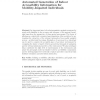Free Online Productivity Tools
i2Speak
i2Symbol
i2OCR
iTex2Img
iWeb2Print
iWeb2Shot
i2Type
iPdf2Split
iPdf2Merge
i2Bopomofo
i2Arabic
i2Style
i2Image
i2PDF
iLatex2Rtf
Sci2ools
151
Voted
AGILE
2015
Springer
2015
Springer
Automated Generation of Indoor Accessibility Information for Mobility-Impaired Individuals
One important issue in developing assistive navigation systems for people with disability is the accuracy and relevancy of the systems’ knowledge bases from the perspective of these special user groups. The theory of affordances coupled with computer-based simulation offers a solution for automating the extraction of the relevant information from readily available sources - architectural floor plans. Simulation of movement in a wheelchair can be used to compute the accessible space of an indoor environment by comparing the degree of match between geometrical demands of navigation and the relevant physical properties of the environment. We also investigate what constitutes the right level of representation of the environment and adopt the grid graph model as suitable both for accessibility computation and for deriving higher-level networks of places and their connections that facilitate orientation and user-system interaction. Key words: building accessibility; affordance simulati...
AGILE 2015 | GIS |
Related Content
| Added | 13 Apr 2016 |
| Updated | 13 Apr 2016 |
| Type | Journal |
| Year | 2015 |
| Where | AGILE |
| Authors | Nemanja Kostic, Simon Scheider |
Comments (0)

